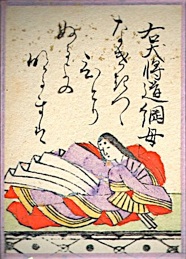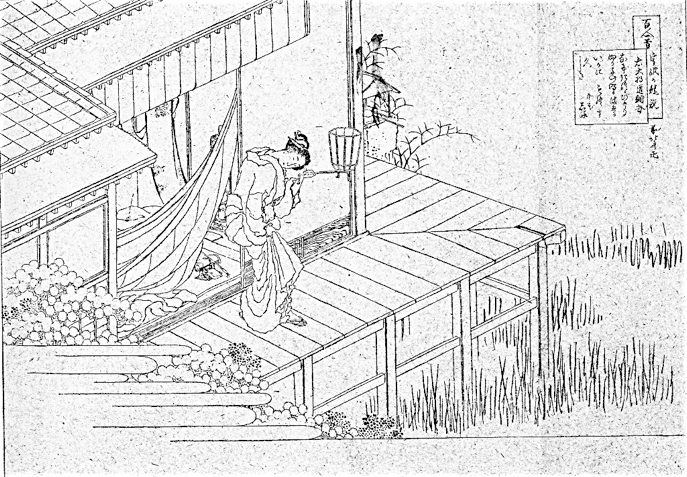右大将道綱母

嘆きつつ
ひとり寝る夜の
明くる間は
いかに久しき
ものとかは知る
うだいしょうみちつなのはは
なげきつつ
ひとりぬるよの
あくるまは
いかにひさしき
ものとかはしる
The Mother of Michitsuna
Lying all alone
Worrying through the night
Till daylight comes,
Do you realize at all
How long that wait is?
Hokusai
Udaisho Michitsuna no Haha (ca. 937 - 995), was married to Fujiwara no Kane’ie (poem 52). Michitsuna no Haha means ‘Michitsuna's mother’; her son's title, ‘Udaisho’ (Commander), is sometimes used. We don't know the author's personal name. We do know that, before her marriage, she was considered an accomplished poet and a beauty. During her marriage, she continued to write; she participated in poetry contests and composed screen poems on commission. Thirty-six of her poems were collected in imperial anthologies. After her husband's death in 990, she may have become a Buddhist nun.
She wrote the Kagero Nikki, a journal of her marriage with Kane’ie, which Edward Seidensticker translated as The Gossamer Years. Kagero literally means ‘summer haze’, from a line at the end of Book 1: "Call it, this journal of mine, a shimmering of the summer sky".
The poem is said to have been sent to her husband, Kane’ie, after he complained about being kept waiting at her gate after returning late at night and he then went off to the house of his new lover.
Yo no akuru means ‘until the following dawn’, but akuru ma could also mean ‘empty room’.
Hokusai’s drawing shows a woman waiting with a lantern for her husband while she has prepared everything in the house for his arrival (tobacco and pipe).


